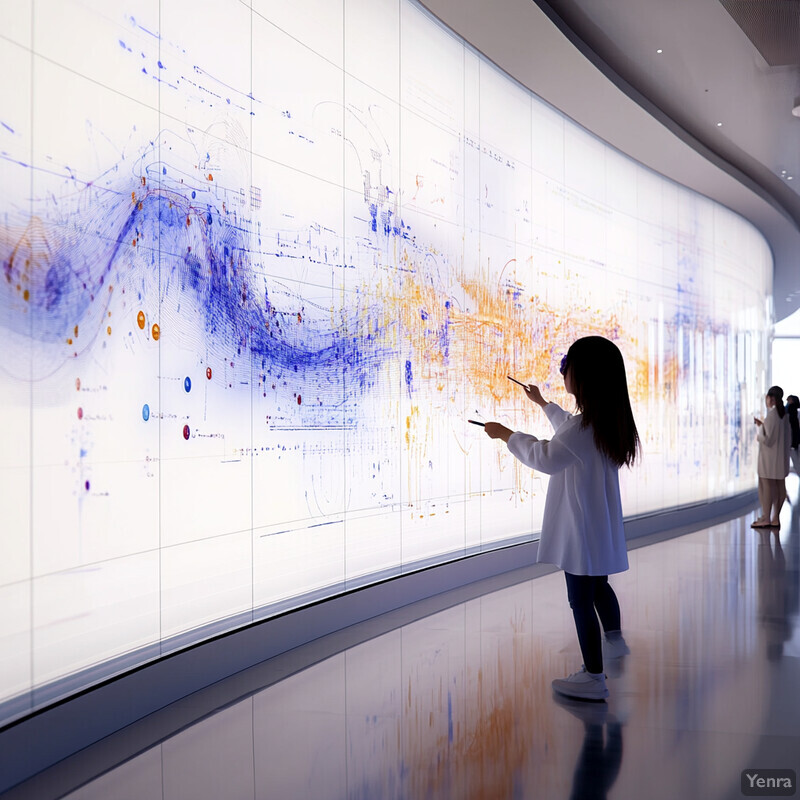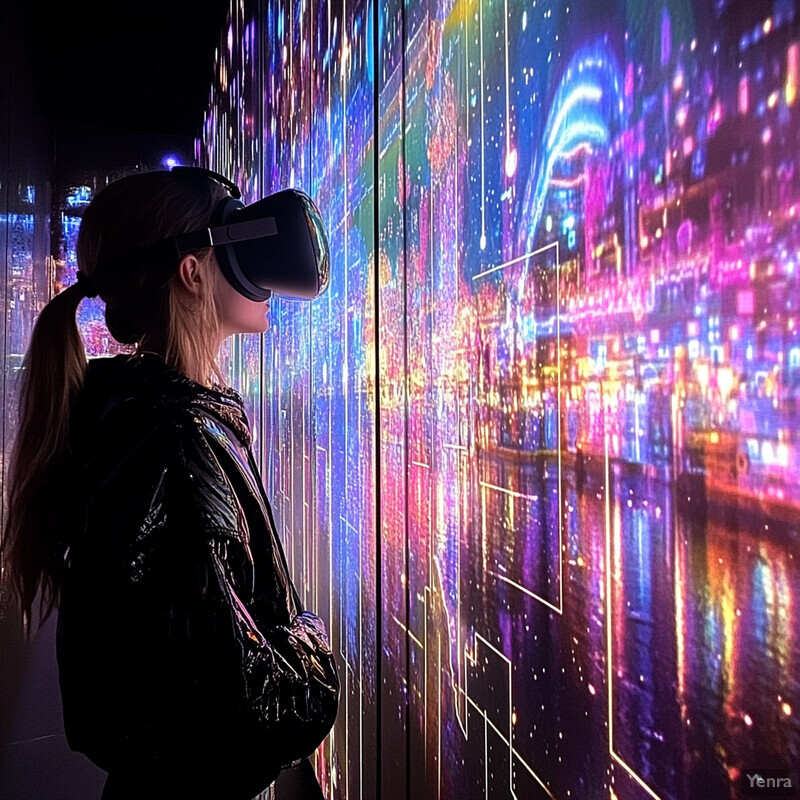1. Real-time Emotion Detection
AI-driven emotion detection uses computer vision and audio analysis to gauge viewers’ real-time affective states (e.g. facial expressions, voice tone). By capturing subtle cues, ads can instantly adjust content to better resonate with each viewer. For example, Lexus developed an “emotionally intelligent” video ad that uses the viewer’s camera to read facial expressions and then changes music, pacing, color, and editing on the fly to match the viewer’s mood. Such real-time adaptation can increase engagement by aligning an ad’s tone with what people are feeling in the moment. While still emerging, these systems aim to make digital ads more responsive and personalized than static campaigns.

Research shows that most consumers feel their emotions are overlooked online, highlighting the potential impact of real-time emotion AI. In one survey, nearly 75% of customers reported their feelings are often ignored during digital interactions. Advances in AI are addressing this gap: computer-vision models trained on millions of annotated video ads can predict the ad’s emotional tone with substantial accuracy (average AUC ~75%). Commercial tests support this: for instance, an AI platform like MorphCast (used by Lexus) adjusts ad elements in real time based on detected emotions. As this technology matures, ads that read and react to viewers’ real-time emotional signals may drive higher relevance and engagement than fixed creative.
2. Personalized Ad Experiences
AI enhances advertising personalization by combining emotional insights with user data. It can tailor ad content not only to demographic or browsing behavior but also to each person’s emotional profile. Personalization makes ads feel more relevant: in fact, studies show that consumers overwhelmingly prefer relevant offers and recommendations. For example, a McKinsey report found that over 70% of consumers expect personalization. By factoring in emotion (e.g. which stories or images make someone smile), AI can further refine individual ad experiences, increasing the chance the message resonates deeply with each viewer.

The business benefits of personalization are well-documented. McKinsey & Company reports that companies leading in personalization earn about 40% more revenue from it than competitors. Likewise, industry surveys indicate that 80% of customers are more likely to buy when brands offer personalized experiences. In practice, AI engines analyze prior emotional reactions (from clicks, scrolls, or past campaigns) to predict which creative elements will best appeal to each user. For instance, dynamic ad platforms might select product photos or taglines that match a user’s mood or preferences. By showing each person ads tuned to their emotional drivers, marketers can boost engagement: one study of AI-generated personalized ads found brand favorability rising 22 percentage points for the tailored version versus generic content. The result is ads that feel unique to the viewer, increasing click-through rates and loyalty.
3. Adaptive Creative Content
AI can dynamically alter an ad’s visual or auditory content in real-time to match a viewer’s emotional cues. This means switching out images, music, voiceovers, or pacing on the fly. By doing so, the ad’s tone stays in sync with the person’s mood, making it more engaging. One real example is Lexus’s “Feel Your Best” campaign: it used facial emotion detection to adjust the ad’s edit and soundtrack while the person was watching. Adaptive creative ensures the message never feels out-of-touch with how the viewer feels at that moment.

In Lexus’s case study, the AI-driven ad had over 3,000 creative variations: by altering parameters like music intensity, colors, and pacing based on viewer feedback, the campaign could choose an optimal version for each person. This led to high engagement; the brand reported that viewers found the adaptive ad more memorable. More broadly, marketers increasingly use AI tools to automate creative decisions at scale. For instance, generative AI can create or select images and videos that fit a given emotional theme. Research shows that when ad content matches the audience’s feelings, outcomes improve: one industry study found ads placed in emotionally congruent contexts saw lifts in effectiveness (e.g. up to ~15% higher purchase intent when the emotional tone matched). By continuously modifying creative elements in response to feedback, AI-driven ads maintain the right mood, boosting the ad’s impact and memorability.
4. Contextual Targeting with Sentiment Analysis
AI-driven sentiment analysis helps place ads in the right context. Instead of targeting individuals by cookies (which are being phased out), marketers use AI to read the mood of content and choose suitable ad placements. This means analyzing the sentiment of social media, news articles, or even program content in real-time, and then showing ads that match that emotional tone. For example, a travel ad might be held back from running beside a somber news story. By aligning ad sentiment with the context’s mood, brands can enhance relevance and avoid jarring mismatches that could turn customers off.

Modern AI platforms scan web content and flag its emotional connotation (positive, negative, etc.) to guide ad placement. According to industry analyses, contextual AI can parse language and visual cues to determine if a page or video has positive or negative sentiment. This allows real-time adjustments, such as placing ads only on pages with uplifting content. In practice, contextual targeting budgets are shifting in this direction; one report projects the global contextual advertising market to reach over $335 billion by 2026 as advertisers seek privacy-safe methods. Advertisers report that sentiment-aware placement improves performance: campaigns shown in emotionally aligned contexts are better received. Studies even show that when ad and context are emotionally mismatched (low similarity), engagement can drop below baseline, whereas high emotional congruence can boost ad effectiveness by up to ~5–15%. Overall, sentiment analysis gives brands finer control over where and when their ads appear, reducing wasted spend and improving return on ad spend.
5. Emotionally Driven A/B Testing
Beyond traditional A/B testing, emotion-driven testing evaluates different ad variants by directly measuring viewers’ emotional responses. AI tools can track facial expressions, voice tone, or galvanic skin response during test viewings of ad versions. The system then statistically determines which creative better hits the target emotion (e.g. joy or trust). The winning variant is the one that elicits the strongest desired emotional reaction. This method enables marketers to optimize ads not just for clicks, but for emotional resonance and brand sentiment.

AI’s ability to decode subtle emotional cues supports this advanced testing. For instance, one AI study demonstrated that models trained on large ad datasets can distinguish high-emotion segments with good accuracy: a published model attained about 75% AUC in classifying an ad’s overall emotional undertone. In practice, firms like Affectiva (now part of SmartEye) and iMotions offer platforms for such tests. They report that running these emotion-A/B tests can dramatically improve engagement: in one industry case, replacing a low-engagement ad with a higher-emotion variant (as identified by AI facial analysis) boosted viewer attention significantly. Moreover, consumer surveys support the rationale: since 75% of customers say their emotions are often overlooked online, using emotional feedback closes an important gap. In summary, AI-enhanced A/B testing picks the creative that best aligns with the audience’s emotional profile, leading to ads that not only reach viewers but move them.
6. Dynamic Storytelling Sequences
AI can customize the narrative flow of an ad to align with each viewer’s journey. Instead of a fixed storyline, the ad’s sequence of scenes or messages may vary based on inferred preferences or emotional state. This might involve shortening certain segments, choosing different character perspectives, or rearranging scenes for maximum impact. The goal is to make every ad feel like a personalized story tailored to the individual. By doing so, brands can create more immersive and memorable campaigns that adapt the story in real time to what is likely to resonate emotionally.

While still an emerging concept, marketers are already leveraging AI to mix and match story elements at scale. AI tools can analyze past campaign data to learn which narrative beats worked best with which audiences. For example, a study noted that combining creative storytelling with personalization can deliver significant lifts in engagement. Harwick’s HBR analysis emphasizes that AI-driven personalization “delivers relevance and innovation at scale” by blending human creativity with data insights. In practice, this could mean that a sports ad shows more game footage to highly excited fans, and more human interest shots to others. In essence, dynamic storytelling treats the ad as a set of modular scenes that AI recombines based on predictive models of emotion. Case studies from other fields (like interactive video) suggest that such customized narratives hold viewer attention better. Overall, data-driven story sequencing promises to make brand stories feel more personal and emotionally impactful for each viewer.
7. Voice Emotion Recognition
AI systems are increasingly able to analyze voice signals to infer emotional state. By processing tone, pitch, pace and other vocal markers, these tools detect feelings like stress, happiness or anger in spoken input (from phone calls, voice assistant queries, etc.). In advertising, this means an ad or voice assistant could adapt its message based on the user’s tone. For example, a supportive or empathetic offer could be delivered if the user sounds frustrated. Incorporating voice emotion adds another layer of context, complementing facial cues and text sentiment.

Major tech companies are actively developing voice emotion tech. As one news report noted, Amazon has patented methods to analyze customer voice tone via Alexa to tailor product recommendations. In research, voice-based AI can distinguish emotions with high accuracy under controlled conditions (accuracies often above 70–80%). Voice analytics is already used in customer service center tools to flag upset callers. For marketing, a 2024 PYMNTS article highlights that voice emotion detection can complement facial cues, noting that companies like Affectiva combine multiple modalities. By the numbers, such voice analytics could enable timing of voice-interactive ads or prompts: if a user’s tone indicates curiosity, the system might offer more information; if a negative tone is detected, it could present a sympathetic offer. Early adopters report that even analyzing stress in voice can help time marketing messages—e.g. pausing a sales pitch until the user is less agitated. Overall, voice emotion recognition adds a powerful new signal for context-aware.
8. Sentiment-Based Creative Briefing
AI can inform creative teams by summarizing which emotions and topics worked best in prior ads. For instance, an AI might analyze hundreds of past campaigns and report that excitement and trust were key drivers of engagement for a given audience. Creative directors can then use these insights to write new briefs. In other words, sentiment analysis turns historical ad data into actionable creative guidelines. This data-driven briefing helps ensure the new ad starts from a place of proven emotional efficacy, increasing the chances that the final creative will resonate.

Data shows that integrating analytical insights into creative planning improves results. A recent report highlights that marketers are using AI-driven analytics to decide “when to send campaigns, who to target, and what content to include”. In practical terms, this means teams examine metrics like emotional response rates and use AI to spot patterns. For example, if analysis reveals that humor worked better than drama in past ads for a segment, the next brief will emphasize comedy. Accenture research also suggests the payoff: 91% of consumers prefer offers that reflect their tastes and behaviors, implying that briefs guided by consumer insight lead to more relevant ads. Ultimately, sentiment-based briefing closes the loop between data and creativity, ensuring brand messages align with known audience emotions.
9. Predictive Emotional Modeling
Predictive emotional modeling uses machine learning to forecast how viewers will feel about an ad before it even runs. Given a draft ad, AI models (trained on thousands of past ads) predict audience reactions, such as how much joy or surprise the ad will generate. Creative teams can then tweak the ad in advance—adjusting scenes, music or messaging—to hit the target emotions. By modeling reactions across different demographics or personalities, brands can fine-tune ads for each segment’s unique emotional preferences, effectively pre-testing at scale without expensive focus groups.

Cutting-edge AI research demonstrates this capability. In Scientific Reports, researchers trained a neural network on 30,000 video ads with 2.3 million viewer emotion annotations. The model predicted the dominant emotion of an ad at 75% AUC, showing strong ability to forecast affect. Such tools can estimate, for example, whether an ad script will evoke happiness or nostalgia in specific regions. In industry, Google and IBM have explored similar ideas; for instance, IBM Watson analyzed award-winning ads to write a new ad script that emphasized the historically most powerful emotional elements (winning awards themselves). On the consumer side, surveys indicate people expect brands to “know them” on a personal level – 72% of shoppers say they expect retailers to recognize them and tailor content accordingly. Together, these data-driven models give brands a “preview” of emotional impact, allowing creatives to optimize the final ad for maximum resonance with target audiences.
10. Adaptive Offer Timing
Emotion AI can also optimize when to present offers. By monitoring cues like engagement level or excitement, systems can detect the peak moment of positive emotional arousal and then trigger a call-to-action. For example, an ad might display a coupon right when the viewer is most amused or curious. This timing maximizes receptiveness. Conversely, it can delay offers if a viewer is distracted or upset. In effect, AI watches the audience’s emotional engagement curve in real time and paces the ad’s sales pitch to match it.

Marketers already use AI-driven analytics to pinpoint optimal timing. A recent industry report notes that advanced platforms analyze user data to decide when to send messages and what content to include. For instance, email marketing tools use machine learning to send emails when a person is most likely to open them. In digital ads, this could translate to holding a special discount until a viewer’s emotional metrics (smiles, nods, etc.) cross a threshold. Case data supports this: in AI-assisted audio ads, the context and pacing of offers were tuned to listener states, leading to large lifts – one study showed personalized contextual ads boosting brand favorability by up to 22 points over generic timing. Such results suggest that matching offer timing to emotional peaks can substantially improve conversion and favorability.
11. Emotional Profiling for Customer Segmentation
AI can profile customers by emotional tendencies and cluster them into segments. Rather than grouping customers only by demographics or purchase history, brands can segment based on emotional traits (e.g. “aspirational optimists” vs. “nostalgic comfort-seekers”). This allows tailoring campaigns to each segment’s affective profile. For example, one segment might receive upbeat, adventurous ads, while another sees warm, reassuring messages. Emotional profiling makes segmentation more fine-grained and psychological, enabling creatives to speak to what each group values most emotionally.

In practice, AI analyzes large data sources – from social sentiment to survey responses – to find patterns of emotional response. For instance, NLP on product reviews or social media can reveal that a certain group frequently mentions ‘joy’ or ‘pride’ in contexts related to a brand. AI then flags these groups for corresponding ad themes. Studies have shown this approach can boost targeting accuracy: IBM reported that using emotional and personality traits alongside demographics improved marketing reach. Moreover, data suggests the payoff: 73% of consumers say they’ll share more personal data if they get valuable personalization in return. In other words, understanding emotional personas is a two-way street, and companies that harness emotion-based segments can create campaigns that resonate on a deeper level, improving response rates and loyalty.
12. Ethical Use of Emotive Data
Handling emotional data requires strict ethics and legal compliance. AI frameworks are putting guardrails in place: for example, the EU’s new AI Act explicitly bans “emotion recognition used for subliminal or manipulative purposes,” and classifies most emotion-detection systems as high-risk. This means advertisers must be transparent about analyzing emotions, get consent, and avoid hidden manipulation. These rules ensure that emotional advertising respects privacy and autonomy. In practice, this means AI systems must securely handle sensitive emotional metrics (like facial or voice data) and use them only in ways users would expect and accept.

Legal experts warn that emotion AI can easily cross ethical lines. Emotional data (tone of voice, facial cues) is considered highly sensitive personal information. According to a recent analysis, misuse could violate privacy laws like GDPR or the California Privacy Act. For instance, using secret algorithms to push someone’s emotional buttons could be seen as manipulative. Under the EU AI Act, any AI that infers emotions to manipulate users is banned. If used at all, emotion-recognition tools are deemed “high risk” and must include transparency, human oversight, and risk mitigation. U.S. regulators have issued similar warnings: the FTC advises companies to clearly disclose any AI emotion analysis and forbids “deceptive practices” that exploit feelings. In short, ethical frameworks require that emotive advertising be done with user consent, honesty, and safeguards to prevent abuse.
13. Neural Network-Based Creative Generation
AI is increasingly used to generate ad creatives from scratch. Neural networks can write ad copy, generate images, compose jingles and even produce video segments. When trained on emotional data, these generators produce content designed to elicit specific feelings. For example, given an emotion target (like “inspire confidence”), an AI copywriter can suggest wording that human testers previously rated as highly motivating. Similarly, AI image tools can create visuals with a joyful or serene vibe based on training examples. This allows brands to rapidly create multiple emotionally-tuned creative options for a campaign.

Early industry experiments show striking results. In one case, an AI copywriting platform (Persado) crafted email headlines and saw a 450% increase in click-through rate compared to a generic version. In another example, an AI system used to design an audio campaign drove a jump in brand favorability by 22 percentage points when it personalized the message content. These cases underline that AI-driven creative (text, audio or image) can outperform standard ads when it captures the right emotional tone. Generative models like GPT or diffusion-based image tools can adjust style and mood on demand, creating thousands of versions. Marketers report that integrating AI in creative workflows significantly boosts output: one report found AI-generated ads garnered 2–3× more organic impressions than non-AI variants. As neural creatives improve, they promise to make dynamic, emotion-sensitive ad production routine.
14. Continuous Emotional Feedback Loops
Future emotion-responsive ads may continuously update based on live emotional feedback from wearables or sensors. For example, a smartwatch could share a viewer’s heart rate or galvanic skin response with an ad platform. In turn, the ad might adjust its content in real time — showing more calming visuals if stress is detected or intensifying excitement cues if the user seems bored. This creates a closed loop where ads adapt continuously: as the viewer’s emotional state changes, the ad’s execution changes back, ensuring an optimal match throughout the interaction.

Though still nascent, companies are exploring “wearable AI” for marketing. One industry blog notes that devices like smart rings, AI pins, and health trackers collect data on metrics such as heart rate and mood, enabling “hyper-personalized” engagement. The AI inside can “interact with users in real time through conversations and suggestions,” deepening trust and personalization. For example, a fitness wearable might signal excitement during an ad for sports gear, confirming interest. Analysts predict that combining data streams (heart rate, location, audio context) will inform new campaign adjustments on the fly. In practice, some brands have begun testing adaptive content in live settings: for instance, a digital billboard might switch to an upbeat ad if an approaching person is smiling. The technology is still emerging, but as sensor data becomes more accessible, real-time emotion feedback loops will enable ads that evolve with the viewer’s feelings, potentially increasing relevance and reducing irritation.
15. Localizing Emotional Nuance
AI makes it easier to localize ads not just in language but in emotional tone. When adapting campaigns for different regions, AI tools can adjust idioms, examples and cultural references to preserve the intended feeling. For example, an ad that feels humorous in one country might be reworded to a more respectful or heartwarming tone in another culture. AI can also detect region-specific sentiment: a platform might flag a certain word or gesture as neutral in one culture but offensive in another. By automating these adjustments, AI helps ensure each localized ad resonates emotionally in its own cultural context.

Cultural localization is crucial: even big brands sometimes flop by missing nuance. Research confirms that poorly localized ads can alienate audiences. To avoid this, companies use AI-assisted translation and localization services that go beyond literal word-for-word conversion. For instance, localization specialists emphasize adapting an ad’s tone and imagery to local preferences. A classic example is Coca-Cola’s “Share a Coke” campaign: in each country, the labels were replaced with locally popular names, creating a personal, joyful connection. This increased the ad’s emotional impact worldwide because it aligned with each culture’s value of personal identity. In practice, AI tools trained on large multilingual datasets are achieving better nuance: surveys show that culturally tailored ads substantially increase engagement and brand affinity. Overall, by respecting local emotional cues, AI-driven localization helps campaigns feel authentic across diverse markets.
16. Conversational Ad Interfaces
Ads are becoming conversational interfaces driven by AI. This means instead of a one-way message, ads on platforms like chat or voice can actually talk with the user. For example, an interactive video ad might ask a viewer questions and adapt its content based on the answers. Voice-activated ads can let users speak to a smart speaker to get product info or place orders. By supporting back-and-forth dialogue, these interfaces make ads feel more personalized and engaging. They effectively turn ad space into a mini-chatbot or virtual assistant that carries on a simple conversation with the audience.

Conversational commerce is a fast-growing trend. According to industry sources, brands are embedding chat and voice interfaces directly into ads. For instance, Smartly.io launched “Conversational Ads” that let users message with a brand in a WhatsApp or Facebook Messenger conversation after clicking an ad. Early data is promising: Smartly reports that 74% of marketers plan to use conversational ads by 2025. These ads can guide customers through custom dialogues (like a travel company using Facebook Messenger to recommend destinations based on location) and have delivered lower costs per lead in real campaigns. By engaging users in a natural chat or voice exchange, brands can gather real-time emotional feedback too, making the interaction feel much more personal. Overall, conversational interfaces blur the line between advertising and service, creating dynamic ad experiences that respond directly to each user’s input.
17. Predictive Sentiment in Emerging Channels
AI-based sentiment analysis is expanding into new media like virtual/augmented reality (VR/AR) and Internet-of-Things (IoT) channels. In a VR ad, for example, AI could analyze a user’s gaze and body language to predict if they find a scene enjoyable or scary. In IoT devices (like a smart fridge or car display), AI could use contextual cues (time of day, recent purchases) plus sentiment trends to choose the right message. Essentially, as new platforms emerge, AI applies the same sentiment modeling to any environment where ads can appear, ensuring content is emotionally appropriate even in interactive and immersive media.

Immersive formats are already evolving with AI. Industry forecasts note that AR/VR ads will allow advertisers to “transport users into brand narratives, creating deep emotional connections”. For instance, an AR shopping app might gauge a user’s surprise or delight when trying virtual products and adjust suggestions accordingly. Early pilots in VR games have experimented with real-time mood adaptation: an ad might switch from upbeat to soothing if a player’s heart rate rises during gameplay. Meanwhile, IoT data is also entering the ad equation: smart devices report context (e.g. fitness tracker knows user just finished a run) so ads can match the emotional state (a refreshing drink after exercise). Market analysts predict these channels will grow quickly; one report even lists “AI-enhanced customer journey mapping” as a top trend, implying that every touchpoint – including emerging ones – will be tuned by predictive emotional AI.
18. Enhanced Customer Journeys
AI can map and optimize the entire customer journey with emotion at the center. It analyzes emotional responses at each touchpoint (awareness, consideration, purchase, etc.) and adjusts the experience accordingly. For example, if a customer shows frustration at the purchase stage (detected via chat sentiment or review scores), the system might trigger a caring message or offer live support. By continuously weaving emotional data through all channels, AI creates a seamless, empathic path from first ad view to post-purchase. The end result is a journey that is not just personalized but also emotionally intelligent, adapting in real time to keep customers satisfied and engaged at every step.

Market research identifies “AI-enhanced customer journey mapping” as a major trend in 2025. Companies are deploying analytics platforms that integrate sentiment and behavior across all channels (social, web, in-store, etc.). These systems can pinpoint where customers experience friction. For instance, an AI might flag that people react negatively to a checkout page layout and recommend changes. Studies show that mapping emotions explicitly helps brands drive loyalty: one marketing report noted that only ~15% of customers think brands truly understand their feelings, highlighting the opportunity for data-driven empathy. Tools like Twilio Segment even advise including “customers’ emotions” at each touchpoint when drawing a journey map. Ultimately, AI ties together isolated campaigns into one journey, using emotional feedback to smooth the customer experience end-to-end.
19. Reduced Emotional Friction
By aligning ads with viewers’ current mood and context, AI reduces “emotional friction” – moments when an ad feels out of place or insensitive. Emotion AI helps avoid mismatches (like a cheerful product promo playing during sad news). It also prevents salesy interruptions at the wrong time. The system continuously gauges whether the user is receptive; if not, it can mute or delay the ad. This ensures ads contribute positively to the experience rather than creating annoyance or dissonance. In practice, emotionally aware targeting acts as a safeguard, smoothly integrating ads into content flow and minimizing jarring surprises.

Academic research shows that emotional congruence between content and ads significantly boosts effectiveness. In a controlled study, ads that were highly emotionally similar to the surrounding content produced 15% higher purchase intent lift, whereas ads that mismatched felt worse than no ad. In other words, if an ad’s mood matches the show or webpage mood, it performs better; if not, it can actually backfire. Real-world examples echo this: in the wake of tragedies, many brands have paused upbeat ads to avoid seeming tone-deaf. AI automates this judgment. It can detect context mood and ensure an ad’s emotion is compatible. By steering clear of negative friction, AI-driven campaigns maintain positive user sentiment. Advertisers report this approach leads to smoother user experiences and higher engagement over time.
20. Holistic Emotional Brand Management
Holistic emotional brand management means tracking and guiding a brand’s overall emotional image across all touchpoints. AI aggregates sentiment data from ads, social media, reviews and customer interactions to form an emotional “score” for the brand. Marketers can see whether the brand is perceived as inspiring, trustworthy, or indifferent, and adjust strategy accordingly. For example, if AI monitoring shows consumers feel a brand is too clinical, the team might pivot to more heartfelt storytelling. This unified emotional perspective helps ensure that all campaigns contribute positively to the brand’s emotional equity, keeping the brand consistent in consumers’ hearts and minds.

Brands that connect emotionally with consumers see much better results. Industry reports find that most brands today fail this test: one survey found 74% of brands could vanish and consumers wouldn’t care. Only a few “meaningful brands” – those that understand and address emotional needs – outperform the market. Emotional data supports this: for example, fewer than 16% of consumers feel companies truly know how to form an emotional bond. This underscores why brands use AI to track emotion: to avoid irrelevance. By measuring sentiment metrics (like affection or stress) and mapping them to brand touchpoints, companies can enact broad strategy changes. A data-driven approach to emotion ensures that brand communications—whether in ads or on social media—move brand perception in the right direction. Ultimately, emotional brand management with AI helps firms build stronger loyalty and growth by making sure consumers consistently feel the right things about the brand.